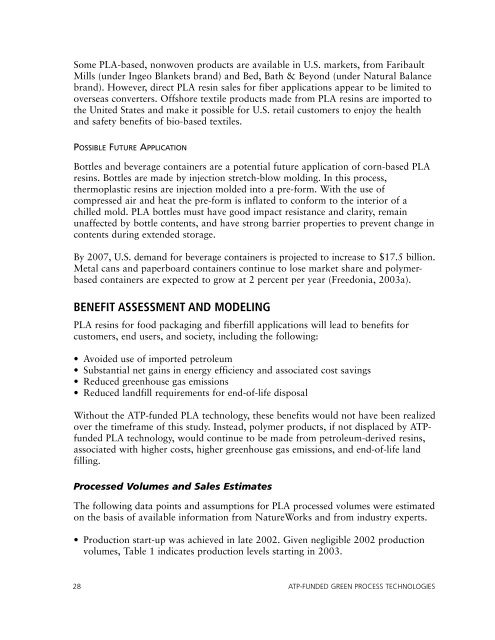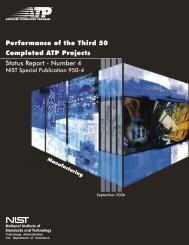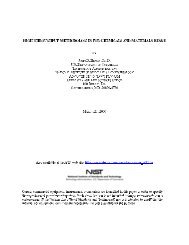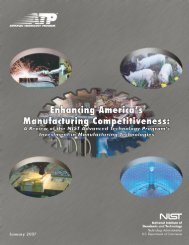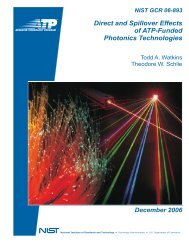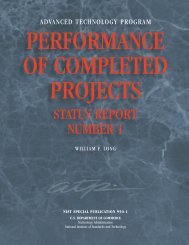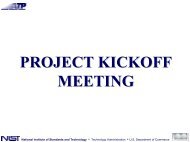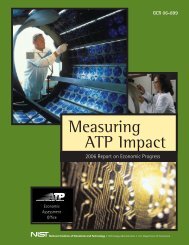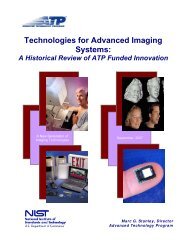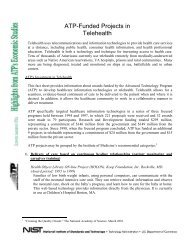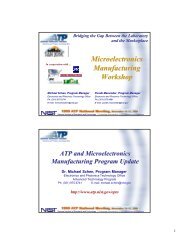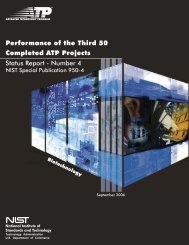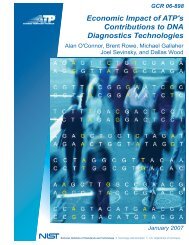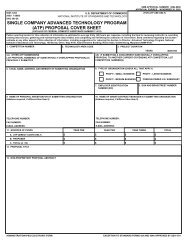ATP-Funded Green Process Technologies - NIST Advanced ...
ATP-Funded Green Process Technologies - NIST Advanced ...
ATP-Funded Green Process Technologies - NIST Advanced ...
Create successful ePaper yourself
Turn your PDF publications into a flip-book with our unique Google optimized e-Paper software.
Some PLA-based, nonwoven products are available in U.S. markets, from Faribault<br />
Mills (under Ingeo Blankets brand) and Bed, Bath & Beyond (under Natural Balance<br />
brand). However, direct PLA resin sales for fiber applications appear to be limited to<br />
overseas converters. Offshore textile products made from PLA resins are imported to<br />
the United States and make it possible for U.S. retail customers to enjoy the health<br />
and safety benefits of bio-based textiles.<br />
POSSIBLE FUTURE APPLICATION<br />
Bottles and beverage containers are a potential future application of corn-based PLA<br />
resins. Bottles are made by injection stretch-blow molding. In this process,<br />
thermoplastic resins are injection molded into a pre-form. With the use of<br />
compressed air and heat the pre-form is inflated to conform to the interior of a<br />
chilled mold. PLA bottles must have good impact resistance and clarity, remain<br />
unaffected by bottle contents, and have strong barrier properties to prevent change in<br />
contents during extended storage.<br />
By 2007, U.S. demand for beverage containers is projected to increase to $17.5 billion.<br />
Metal cans and paperboard containers continue to lose market share and polymerbased<br />
containers are expected to grow at 2 percent per year (Freedonia, 2003a).<br />
BENEFIT ASSESSMENT AND MODELING<br />
PLA resins for food packaging and fiberfill applications will lead to benefits for<br />
customers, end users, and society, including the following:<br />
• Avoided use of imported petroleum<br />
• Substantial net gains in energy efficiency and associated cost savings<br />
• Reduced greenhouse gas emissions<br />
• Reduced landfill requirements for end-of-life disposal<br />
Without the <strong>ATP</strong>-funded PLA technology, these benefits would not have been realized<br />
over the timeframe of this study. Instead, polymer products, if not displaced by <strong>ATP</strong>funded<br />
PLA technology, would continue to be made from petroleum-derived resins,<br />
associated with higher costs, higher greenhouse gas emissions, and end-of-life land<br />
filling.<br />
<strong>Process</strong>ed Volumes and Sales Estimates<br />
The following data points and assumptions for PLA processed volumes were estimated<br />
on the basis of available information from NatureWorks and from industry experts.<br />
• Production start-up was achieved in late 2002. Given negligible 2002 production<br />
volumes, Table 1 indicates production levels starting in 2003.<br />
28 <strong>ATP</strong>-FUNDED GREEN PROCESS TECHNOLOGIES


